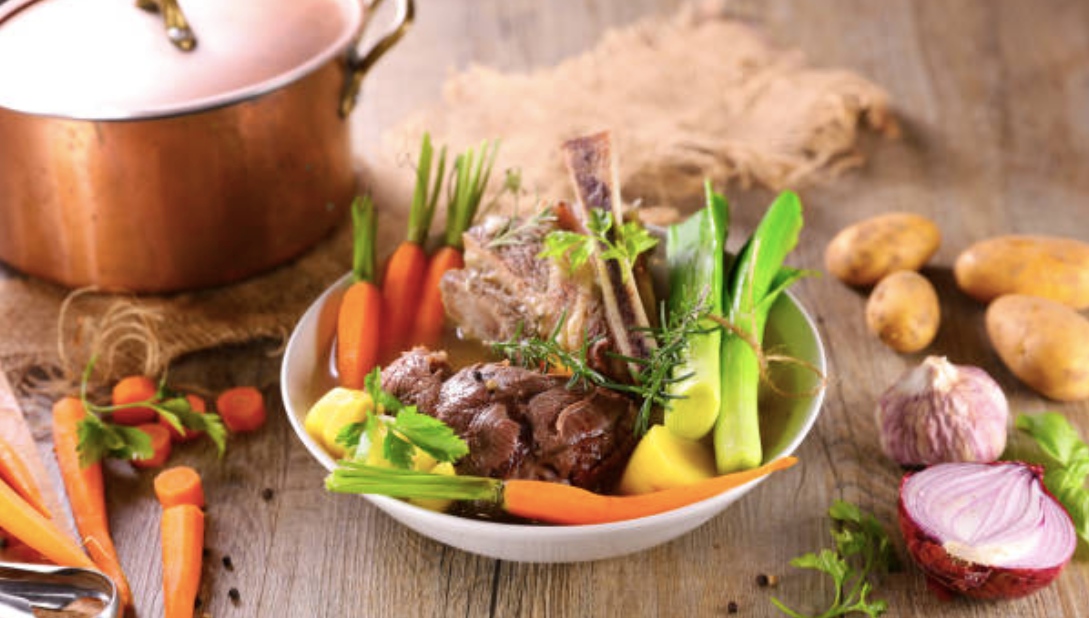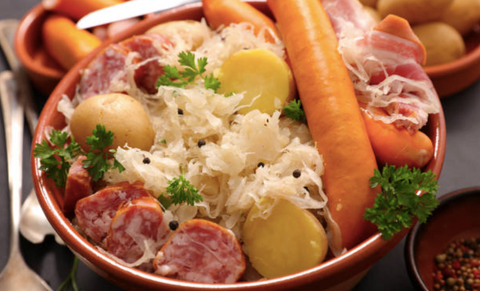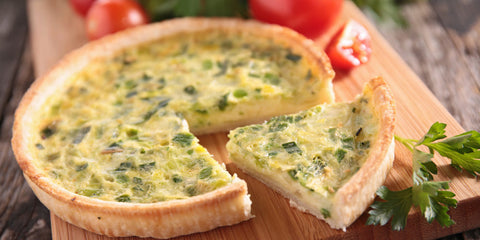The French national dish is Pot-au-Feu (Pot on the fire). It is a soup with vegetables and meat. The meat is often beef but sometimes pork. There are also different kinds of vegetables and spices in it.
The name pot-au-feu comes from the French language and means "pot on the fire." This name comes from the fact that it was often made in one pot put on the fire.
- Pot-au-feu was originally a peasant dish of meat and vegetables boiled together served with salt and vinegar. The pot-au-feu is the most emblematic dish of French cuisine. It is the most favorite family meal and very popular in France. It gives strength, warms the body and heart, and is pleasing.
Pot-au-feu is made up of meat
Traditionally, it is made with beef meat (usually ribs).
Pot-au-feu begins with a bouillon in which legumes and vegetables are cooked. Once cooked, the bouillon is filtered to separate the vegetables from the broth. These vegetables are served as a side dish with a piece of boiled beef (standard shank), accompanied by salt, sweet mustard, or horseradish sauce. In some regions, pork tails or necks are added to the broth for their taste.
The bouillon can be used as a base for many other dishes: soups, sauces for pasta, rice, or legumes. It can also be drunk alone or with croutons, which gives it an excellent flavor.
Eating a French pot-au-feu
Pot-au-feu is a classic French dish, but it's like a lot of classics in that there are many ways to make it.
- The first thing to know about pot-au-feu is that it's more of a method than a recipe. It translates literally as "pot on the fire" and refers to the long; slow cooking that turns tough cuts of meat into tender stews.
- For example, think about what happens when you cook beef brisket for six hours or pork shoulder for 12: The connective tissue breaks down, and the collagen melts away, leaving behind rich, melt-in-your-mouth meat. That's precisely what happens when you make pot-au-feu.
So, what goes into pot-au-feu? The answer is everything. While there are regional variations across France, any pot-au-feu worth its salt starts with a big cut of beef and some vegetables. From there, the recipe diverges wildly — you might find chicken feet in one version and lamb shanks in another — but the most traditional version will include marrow bones (for flavor), potatoes (for starch), and carrots (for color).
Pot-au-feu is classic stew
It is a classic French stew of beef and root vegetables enriched with marrow. I'm always surprised that it's not more popular in Britain, given the current vogue for long, slow cooking. I have taken the liberty of adding some crushed juniper berries and a bottle of red wine to my version; they're not part of the original recipe, but they add an intoxicating depth.
Pot-au-feu should be served in its cooking pot at the table as a first course (it is also delicious cold). For each serving, you will need several pieces of meat and one or two vegetables – any combination you choose.
How to cook pot-au-feu
The key to making a good pot-au-feu is using meat cuts with enough fat and connective tissue to make it a hearty stew. The meat is first simmered in water then served with the cooking liquid.
The first step to making pot-au-feu is deciding which cuts of beef you want in your stew. Here is a list of suggested amounts:
- Chuck roast
- Brisket
- Shank
- Flank steak
- Oxtail
Once you have decided on your cuts, trim any excess fat from the meat, but leave a little fat on if you like. Next, add the meat to a large pot and cover it with water. Bring it up to a boil, and then turn down the heat until it's just barely simmering.
Then add some vegetables such as potatoes, onions, carrots, celery, and garlic. You can also add herbs such as thyme and bay leaves for flavor. Cover the pot and let your pot-au-feu cook for about 5 hours or until the meat is nice and tender. If there isn't enough liquid in the pot, add more water as needed so that everything stays covered with liquid while cooking.

Meaning of pot-au-feu
Pot-au-feu is one of the great classical dishes of French cuisine. It's a simple simmered stew made with nothing more than beef, carrots, turnips, and onions. Pot-au-feu means "pot on the fire" in French. The dish is slow-cooked in a pot over an open flame for 6 to 8 hours.
- For centuries, the French have been making pot-au-feu, and no two pots are the same. Some traditional French cooks even use their leftover pot-au-feu from the day before as the base for a new stew.
- The meat used in pot-au-feu can be beef brisket, short ribs, or oxtail, but there are no hard and fast rules about using. The vegetables vary considerably too — depending on what's in season or what you have on hand — but carrots and turnips seem to be essential ingredients in most recipes.
Pot-au-feu is served as a complete meal with some crusty bread and a salad or vegetable side dish, but it's also common to do the broth first as a soup course and then bring out the meat and vegetables separately later on. So in addition to eating it at home, you can also find it.
How is pot-au-feu eaten?
Pot-au-feu is a French dish that translates to "pot on the fire." It's a traditional dish in France, but it can be made any time of year. The dish consists of beef and vegetables that have been cooked in water until tender.
- Pot-au-feu is eaten at dinner time, typically with wine, bread, and cheese. The broth is served as the first course, then the meat and vegetables are served on a platter as the second course. Finally, the meat is eaten with a sauce made from broth and mustard or horseradish.
- Pot-au-feu is classic French meat, root vegetables, and broth. It's hearty, tastes excellent, and can be prepared in advance.
- The dish begins with beef brisket and beef shank (or shin). These cuts are boiled for hours with a bouquet garni of parsley stalks, onion, garlic, celery, and leek.
- A bouquet garni is simply a bundle of herbs tied together; it's used to infuse flavor into the cooking water.
Typically, you will cook the meat for about three hours until it is fork-tender. Then, if you have time, you can let the meat rest in the fridge overnight.
Decant the broth and refrigerate separately. This way, you can remove any fat that has risen to the top of the broth, making it more transparent and tastier.
When serving, slice up your meat and add to a big bowl along with your root vegetables - carrots, celeriac, and turnip - which you have also cooked in the broth.
Add a few sprigs of fresh parsley to the bowl and pour over enough hot broth to cover everything.
Origin of pot-au-feu
Pot-au-feu (which means "pot on the fire") comes from the French tradition of long, slow-cooked stews. It is an essential dish in French cuisine, as it is seen as a symbol of warmth, comfort, and home cooking.
- The recipe varied over regions, but traditionally it included beef brisket or short ribs, root vegetables (like carrots and turnips), herbs, and spices. Like most other stews, the ingredients were cooked together over low heat for several hours until they formed a rich broth with tender meat.
Pot-au-feu was usually served in two courses: First came to the meat with bread, then the broth was served separately with vegetables.
Pot-au-feu with chicken
Pot-au-feu is a classic French dish that can be served as a soup or stew, depending on how you finish it. In this recipe video, you'll see how to make pot-au-feu with chicken. First, simmer carrots and onions in beef broth before adding beef chuck roast, chicken breast, and potatoes. It's an actual one-pot meal that cooks in under an hour. Next, top each bowl with chopped parsley and serve with crusty bread.
Pot-au-feu in the slow cooker
First thing's first: If you're looking for a great recipe for pot-au-feu, you're in the right place. But if you're looking for a recipe for slow-cooking pot-au-feu, you're probably at the wrong home. A proper pot-au-feu requires low and slow cooking, but not a slow cooker. It needs to be on top of the stove.
- Pot-au-feu translates as "pot on the fire," and that's how it should be cooked — on top of the stove. You can cook it in a regular stockpot or a Dutch oven, but it's usually made in an earthenware pot called a cocotte. Either way, cooking it low and slow is the key to success.
- A traditional pot-au-feu is made with beef chuck roast, carrots, potatoes, onions, leeks, and herbs like bay leaves and thyme. In this version, we take advantage of the slow cooker by including some stricter cuts of beef like brisket and short ribs that break down over time into tender pieces of meat that are so flavorful they don't need any sauce or garnish.
Sauces for pot-au-feu
Pot-au-feu is a traditional French beef stew. It's a simple dish, cooked in broth, with little added flavor aside from the vegetables that might be included in the pot.
The dish is served in two parts. The first course is a broth with vegetables, and the second course consists of meat and vegetables.
Some condiments are often provided at the table to add taste to this rather plain dish.
Here are some typical sauces for pot-au-feu:
- Horseradish sauce (sauce raifort) is often used for pot-au-feu. It's made by mixing grated horseradish with mayonnaise or cream. It's pretty intense, so it's served on the side.
- Moutarde à l'ancienne is solid and sharp grain mustard, but it also has sweet and fruity notes. This mustard can be used on its own or mixed with mayonnaise or cream to make a sauce for pot-au-feu.
- Aïoli is another condiment that's often served with pot-au-feu. Aïoli is made by whisking garlic into mayonnaise until it becomes.

Wine pairings with pot-au-feu
Pot-au-feu is a classic French dish. It's a beef and vegetable stew, similar to the traditional American beef stew, but made with much higher quality meat and vegetables. As a result, the taste of pot-au-feu is rich and hearty but not overwhelming.
Wine pairings with pot-au-feu should be chosen carefully because many different elements are involved in the flavor profile. You want a wine that will bring out the best in these flavors without overpowering the stew or being overpowered by it.
- Pot-au-feu is an excellent meal with a light red wine from France or California. The lightness of the wine will complement the heartiness of the dish without being overwhelming.
- A light red wine will also make for easy sipping throughout your meal, which is essential with this kind of stew because it goes well with plenty of bread to soak up all the sauce!
- If you prefer something lighter than red, this dish can also be paired with a full-bodied white wine. An oaked Chardonnay is like those from Burgundy or California's Napa Valley region. Both regions use oak barrels during the fermentation process.
Pot-au-feu is unique, a once-a-year meal, but so much more than just a dinner. It's a ritual, an occasion that brings family and friends together to celebrate the moment.
Pot-au-feu (which means pot on the fire) is by no means complicated. On the contrary, it's a simple dish that requires very little in the way of skill or technique. And yet it's one of those dishes that only the best chefs ever get round to preparing, let alone perfect. The reason for this is that it takes time — about ten hours — and patience, two qualities that are increasingly rare in today's kitchens.
- The secret to truly great pot-au-feu lies not in what you put into the pot but in how you cook it. If you rush it, you'll end up with a mess of tough meat and over-cooked vegetables that taste like nothing more than boiled cabbage and turnip.
- But done correctly, pot-au-feu becomes a dish of great depth and complexity, with each ingredient contributing its unique flavor to the whole.




